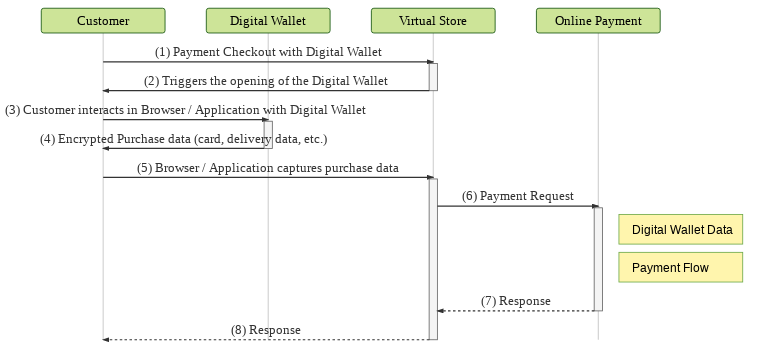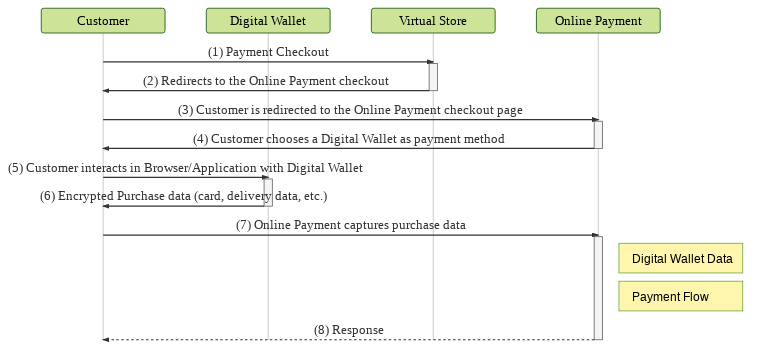Digital Wallets
A Digital Wallet is an application that securely stores credit/debit/voucher cards in order to facilitate the buyer when performing a payment.
Digital Wallets alone provide only cardholder/card information, and a payment method is required to use this data to actually perform the payment.
The Carat Portal fits into this flow as the Payment Gateway.
This page aims to clarify how a Digital Wallet integrates with Carat Portal services.
Supported Digital Wallets#
The Carat Portal supports the following Digital Wallets:
Routing/Acquirers with 3DS authentication support#
When adding a card within a Digital Wallet it is possible (when supported) to perform authentication (3DS) during the registration process. When a card is registered in this way, the Digital Wallet will pass on this authentication data to Carat Portal, which in turn will pass on this data to the acquirers.
The routing/acquirers that support 3DS authentication are:
[*] Contact our Carat Portal support team for more information on 3DS authentication support on SiTef.
Integration flow via REST Payment#
For further information about REST Payment, access the REST Payment - Overview page.
Below will be presented the basic flow of Digital Wallets integration with Carat Portal using the REST Payment interface.
In this scenario, the integration with the Digital Wallet is splitted between Virtual Store and Carat Portal:

- The Costumer initiates the checkout process inside the Virtual Store and chooses a Digital Wallet as the payment method.
- The Virtual Store, which integrated with the first stage of the Digital Wallet integration (opening the wallet) will show the Digital Wallet interface to the Costumer.
- The Costumer will choose, within the Digital Wallet, the card that will be used to make the payment for the purchase.
- After the Costumer chooses the card, the Digital Wallet will return the encrypted card and purchase data to the Virtual Store application.
- With the encrypted data in hand, the Virtual Store will transfer it to our REST Payment interface through the
card.wallet_transaction_idfield. - The Carat Portal will receive the encrypted data and decrypt it, that is, Carat Portal will have access to the card data to send it to the acquirers to effectively perform the payment.
- The Carat Portal returns to the Virtual Store the transaction result.
- The Virtual Store in turn passes the response from Carat Portal to the Cosutmer.
Integration flow via HTML Payment#
For further information about REST Payment, access the HTML Payment - Overview page.
Below will be presented the basic flow of Digital Wallets integration with Carat Portal using the HTML Payment interface.
In this scenario, the integration with the Digital Wallet is carried out entirely by Carat Portal:

- The Costumer initiates the checkout process inside the Virtual Store
- The Virtual Store initiates a transaction and redirects the Costumer to the Carat Portal checkout page.
- The Costumer, already redirected to the Carat Portal checkout page, verifies the payment options.
- The Costumer chooses a Digital Wallet as payment method.
- The Digital Wallet interface will be displayed for the Costumer who then chooses the card.
- Digital Wallet will return encrypted card/purchase data to Carat Portal.
- The Carat Portal will receive the encrypted card/purchase data and will decrypt it, that is, it will have access to the card data to send it to the acquirers to effectively perform the payment.
- The Carat Portal returns the result of the transaction to the Customer.
Contents of the card.wallet_transaction_id field#
The content to be sent in the card.wallet_transaction_id field via the REST Payment interface varies according to the Digital Wallet to be integrated. Consult the specific documentation for more details.